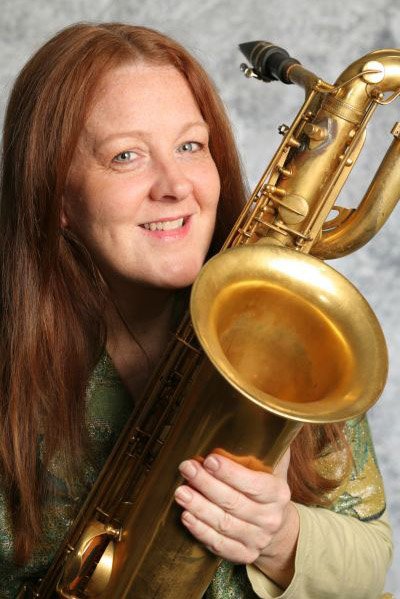 Facebook
Facebook
 X
X
 Instagram
Instagram
 TikTok
TikTok
 Youtube
Youtube

Claire Daly blows the biggest of big saxes, the baritone sax. It is a monster, maybe twice the size of its cousin, the tenor sax. It takes big air to make sound come out of it. You could faint switching up from alto or soprano. When you blow into a bari, the low registers cause your head to vibrate. It takes dedication to develop strength in the facial muscles needed to bite down on the giant mouthpiece. At close to 20 pounds, it is a workout to carry one for any length of time, a subject that I am not unfamiliar with, having played bari sax in the Crawford High School marching band of the 1970s. I began on alto. The teacher switched me to baritone sax either because I was big enough to hold the thing or he didn’t like me very much.
As a musical anchor, the bari sax serves to punctuate the sentences laid out by the soloists. It is therefore both memorable and forgettable, and DownBeat magazine finally came up with a form of acknowledgement for those sorts of instrumental moments.
Claire Daly, who herself is not all that much bigger than a bari sax, has won their “Talent Deserving Wider Recognition” critics’ poll six times. The Jazz Journalists Association made her their pick in ’05, and she’s nailed DownBeat’s Rising Star award a half-dozen times.
Her approach to the giant sax is intelligent and full of soul, respectful of her predecessors but original. She blows with the best of them. A former tenor-alto-soprano saxist, she told a reviewer that the first time she played a bari, she knew she had found her voice. Bill Clinton agreed. A tenor sax man himself, when he was in the White House her Swing Low was said to be one of his faves; a copy is headed for permanent inclusion in his presidential library.


Claire Daly blows the biggest of big saxes, the baritone sax. It is a monster, maybe twice the size of its cousin, the tenor sax. It takes big air to make sound come out of it. You could faint switching up from alto or soprano. When you blow into a bari, the low registers cause your head to vibrate. It takes dedication to develop strength in the facial muscles needed to bite down on the giant mouthpiece. At close to 20 pounds, it is a workout to carry one for any length of time, a subject that I am not unfamiliar with, having played bari sax in the Crawford High School marching band of the 1970s. I began on alto. The teacher switched me to baritone sax either because I was big enough to hold the thing or he didn’t like me very much.
As a musical anchor, the bari sax serves to punctuate the sentences laid out by the soloists. It is therefore both memorable and forgettable, and DownBeat magazine finally came up with a form of acknowledgement for those sorts of instrumental moments.
Claire Daly, who herself is not all that much bigger than a bari sax, has won their “Talent Deserving Wider Recognition” critics’ poll six times. The Jazz Journalists Association made her their pick in ’05, and she’s nailed DownBeat’s Rising Star award a half-dozen times.
Her approach to the giant sax is intelligent and full of soul, respectful of her predecessors but original. She blows with the best of them. A former tenor-alto-soprano saxist, she told a reviewer that the first time she played a bari, she knew she had found her voice. Bill Clinton agreed. A tenor sax man himself, when he was in the White House her Swing Low was said to be one of his faves; a copy is headed for permanent inclusion in his presidential library.